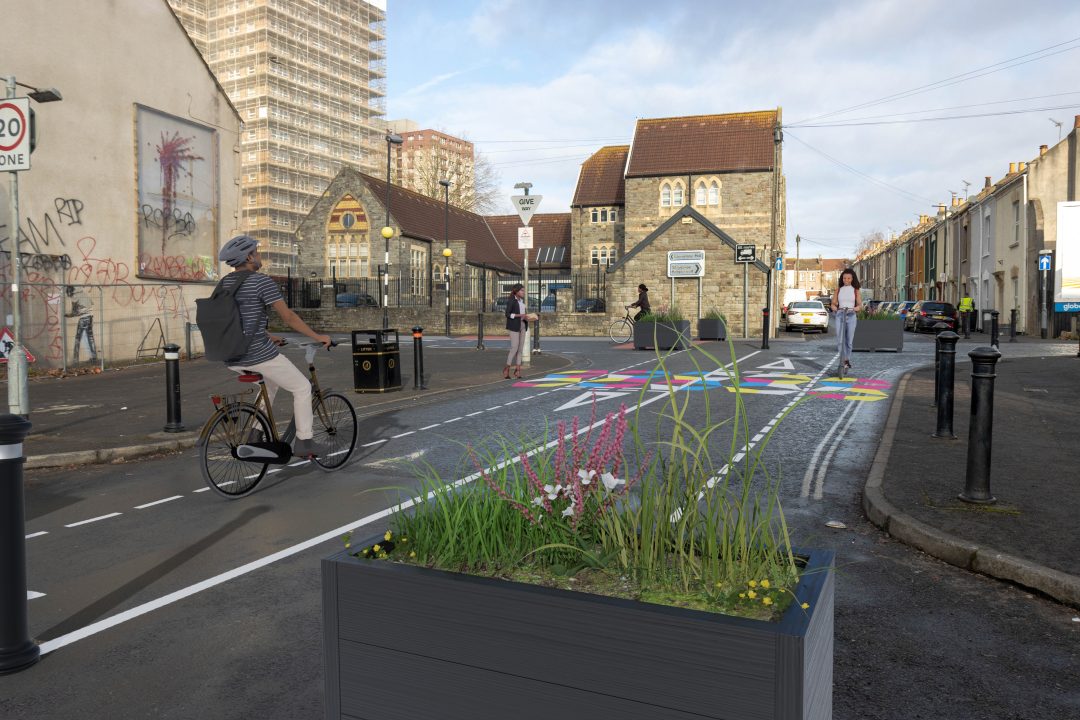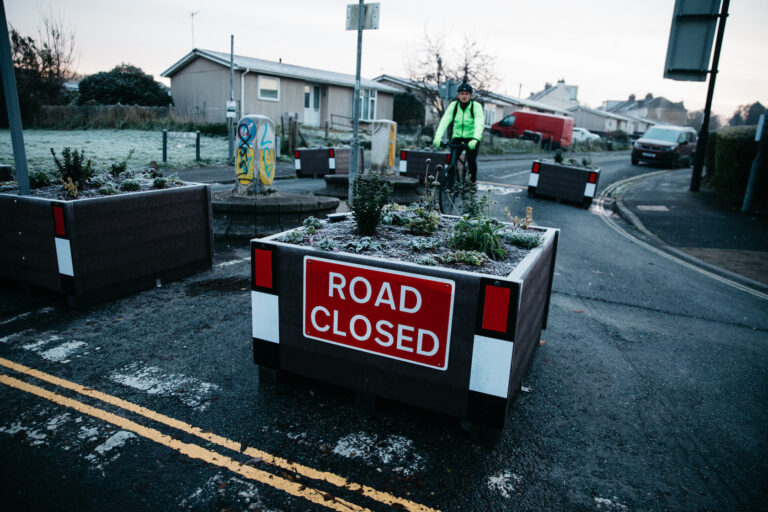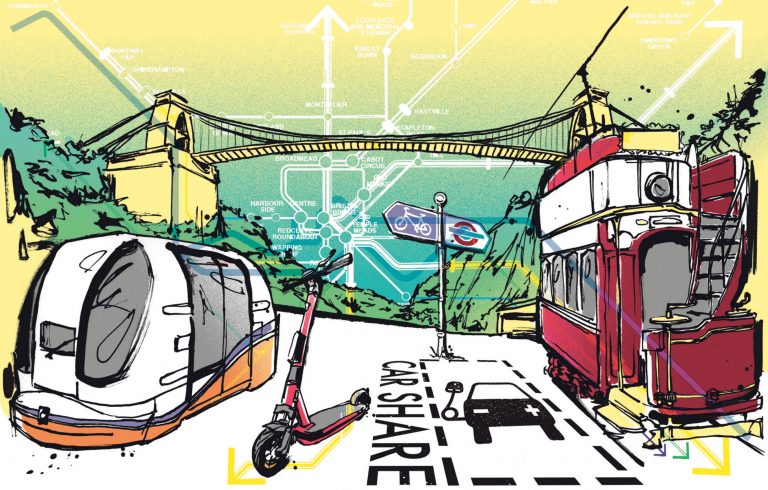Car-free utopia or burning bollards: how can Bristol build a truly ‘liveable’ neighbourhood?

From the windows of his espresso bar in Dergano, a residential area north of Milan’s city centre, Angelo Zhao saw his neighbourhood’s main square completely redesigned. Piazza Dergano used to have few of the typical attributes of an Italian piazza: two roads and four rows of parking spaces, with little space for anything else.
“It was a car park,” Zhao remembers. “The parking spots were always taken.” He says the piazza was dirty, too: sometimes, when he opened his bar at 6am, he would spot the stains and smells of where people had peed the night before, hidden by cars.
But in 2018, the square underwent an architectural revolution. First, the city council used ‘tactical urbanism’ – a way of changing urban spaces quickly and at low cost. Authorities expanded the pavement, removing one road and the parking spaces, painted the asphalt, and added benches.
Then, in 2021, construction crews made the changes permanent. Piazza Dergano became a pedestrianised cobbled square with 12 benches, three bicycle racks, two picnic tables, two table tennis tables and new trees.
“It’s much nicer now,” Zhao says. “It’s cleaner and more elegant.”
Piazza Dergano was among the first squares in Milan to undergo this makeover. Under the ‘Piazze Aperte’ (‘open squares’) scheme, Milan has renovated 38 squares and streets, restricting traffic and parking to allocate more space to pedestrians.
This is no Scandi car-free paradise. Milan is one of Europe’s most congested cities. Yet the scheme, although not without flaws, has managed to reallocate space away from cars and breathe life back into neglected public spaces outside the city centre.
In the UK, low traffic neighbourhoods have sparked car culture wars in London and most recently in Oxford, where they even became the subject of a conspiracy theory.
Bristol is about to introduce its first ‘liveable neighbourhoods’ scheme in Barton Hill, Redfield and St George, to reduce through-traffic and improve walking and cycling. What can we learn from Milan, London and Oxford’s low-traffic neighbourhoods experiment?
Too many cars?

Following single-road schemes in Clifton and Cotham Hill, where through-traffic was stopped, Bristol City Council has been considering restricting cars over a larger area in East Bristol, in the first of two liveable neighbourhood pilots.
The East Bristol Liveable Neighbourhood zone spans from Lawrence Hill to Troopers Hill, between Church Road and Feeder Road, where cars squeeze down a dense grid of residential streets.
“We fight for space,” said one longtime St George resident. The Cable has spoken to residents about pavement parking causing mobility issues, cars rat-running down the narrow streets to avoid Church Road, and Beaufort Road in particular feeling unsafe after a history of road collisions.
Over the last year, the council held a thorough consultation and co-design process with local people, and has submitted a business case for the £6 million scheme to WECA. The consultation showed the biggest issues in the area are too much traffic, driver behaviour and streets not being pedestrian-friendly.
Now the details of the trial scheme have been revealed, placing major new restrictions on vehicles from driving through the area.

The consultation shows initial support for the liveable neighbourhood from local people. But concerns have swirled online about traffic being forced onto surrounding roads, the impact on emergency services, and the poor state of Bristol’s public transport as an alternative to cars.
At a recent council meeting, local resident Chris Johnson said the scheme would “dramatically curtail freedom of movement for many”, which would be “entirely undemocratic”, because it would affect the poorest, most vulnerable and disabled residents.
Organised opposition to the liveable neighbourhood hasn’t emerged. But these kinds of comments show the strong resistance people have to driving less.
Debate and division: London and Oxford’s low-traffic neighbourhoods
Bizarrely, a traffic scheme in Oxford recently became the subject of a conspiracy theory and even caught the attention of Canadian rightwing self-help guru Jordan Peterson.
In February, 2,000 people gathered to protest against the idea of a ‘15-minute city’ – where everything you need in your local area is only a short walk or bike ride away. Conspiracy theorists thought this meant an authoritarian local government confining people in the area, using sinister surveillance.
In another sign of how extreme the low-traffic neighbourhoods debate has become, Oxford hotel owner Jeremy Mogford compared a local councillor supportive of the scheme to Josef Mengele, a German SS officer who performed deadly experiments on prisoners in Auschwitz. He later apologised.
But there have been more rational concerns raised about low-traffic neighbourhoods since they were introduced to Oxford in 2021. The council faced criticism that they reduced footfall for businesses on neighbouring high streets and caused heavy congestion on surrounding roads. It is considering whether to replace bollards, which have been vandalised repeatedly, with vehicle recognition cameras.
London low-traffic neighbourhoods brought in during the pandemic proved divisive too. In some cases, backlash led to schemes being scrapped, but new evidence is emerging showing the benefits.
A comprehensive study on the impact of 46 low-traffic neighbourhoods in London by the University of Westminster’s Active Travel Academy seemed to show they reduced traffic within their boundaries without always pushing it onto roads around their edges.
Another review of evidence by the Centre for London found strong evidence that low-traffic neighbourhoods reduce the overall number of car journeys in and around the area and encourage people to use other transport. Although they may move some motor traffic to nearby roads in the short-term, this reduces with time.
The review found good design, engagement and communications can make low-traffic neighbourhoods more effective and less controversial. It said street improvements such as wider pavements, trees and greenery can increase low-traffic neighbourhoods’ benefits, and that there must be support to help people switch to other transport, and plans to mitigate negative impacts. Early and comprehensive public engagement will improve public trust and schemes’ quality, it said.
Oxford showed how low-traffic neighbourhoods can descend into division. But the evidence from London shows that if schemes are trusted by the local community thanks to good design, engagement and improvements that aren’t purely about reducing traffic, they can make a positive impact.
What has been the response in Milan?

This mission to improve public spaces and create more liveable neighbourhoods is at the centre of Milan’s ‘open squares’ project.
The open squares are all in the suburbs, outside Milan’s wealthier centre. “We wanted to breathe new life into the neighbourhoods and nudge these areas towards becoming new ‘centres’,” says Pierfrancesco Maran, the councillor who was a driving force behind the makeover.
Maran says Milan’s previous pedestrianisation of central areas, inspired by Times Square in New York, only had partial success because works were slow to complete and spaces underused.
That’s when Milan started using tactical urbanism – spraying colourful paint on the asphalt and adding temporary elements to pedestrianise squares quickly. This allowed residents to see how public space could be used differently, and to decide if they wanted to keep the changes.

Milan’s 38 open squares all started as small tactical urbanism experiments costing between €15,000 and €60,000 each. So far, only the first two, including Dergano, have been made permanent, which cost around €700k.
On a recent visit by the Cable, two dozen people, many of them elderly, sat on the benches in Piazza Dergano, while families with children strolled by. Most residents had positive views of the new square. “It has become a gathering point,” says Renzo, a pensioner in his early seventies and long-time resident. “People sit here, meet, chat.” Costanza, another resident, said spending time in the square had become “a lot more pleasant.”
But Piazza Dergano’s makeover also attracted criticism. One resident said the piazza’s cobblestones made it difficult for older people using walkers, and children on roller skates. Even Renzo complained of noise in his apartment looking onto the piazza. “At night, the tables are always taken by people who eat, drink, party… sometimes until 3am,” he says.

Right wing opposition politicians have argued the reduction in roads and car parks, together with the Open Squares scheme, have adversely affected hundreds of thousands of commuters, workers and parents of school-age children who drive into Milan.
Paola, another long-time resident, said that while she likes the project, mobility and parking have become undeniably worse. “You have to do 50 laps and use half the tank to park,” she says, adding that she hardly ever drives. “They reduced the street to one lane, so if a car stops for a few minutes, then a bus comes, then a van… then you have a jam.”
What can we learn from Milan?
In one of Milan’s new piazzas, cyclists increased by 47% and pedestrians by 30%. But Maran admits that authorities collected limited data on the scheme’s impact, and are yet to commission air quality studies.
He says residents haven’t voiced serious concerns about the scheme negatively impacting mobility, and that the council has tried to keep projects small to minimise disruption. Maran also acknowledged changes should go hand-in-hand with public transport improvements to mitigate those impacts and enable people to move around differently.
“Right now, the model is that those who live in the suburbs have no choice but to come into town. But what if there were attractive things in those areas too, so residents don’t have to shop or find a job in the centre?” he says. “It’s not about creating fences but creating attractive, pleasant places near home, and allowing people like the elderly, who risked remaining segregated at home, to move freely.”
He still considers the scheme a success: most squares are no longer discussed because “they have been absorbed in the neighbourhood without any problems”. He says the schemes have only ever been tweaked, never abandoned, after criticism.
The most important lesson, he says, is that low-traffic neighbourhoods projects are much more likely to be well-received if the community is engaged. In the next round of the scheme, residents have nominated more than 80 piazzas, and Maran hopes the council can partially pedestrianise at least 30 of them, with an emphasis on adding children’s playgrounds near schools.
In his espresso bar, Zhao is happy about the new Piazza Dergano. He says his bar’s rent has risen at least 20%, but he is not worried because business is also booming. “It brought us a lot of work – groups of friends come, sit, party,” he says. “People spend a lot more time in the piazza.”
Bristol City Council seems aware of the importance of community engagement with the East Bristol Liveable Neighbourhood. Now that the first details of the trial scheme have been announced, the real work begins.
Another clear lesson from Milan is the importance of revitalising public space and greenery. Sceptical residents are more likely to accept low-traffic neighbourhoods’ restrictions on driving if they feel they’re gaining other benefits.
Bristol’s cabinet member for transport, Don Alexander, said: “We have seen from other schemes that using a co-design approach to develop proposed interventions for the scheme with communities is key to success.
“We’re starting the trial East Bristol Liveable Neighbourhood scheme with interventions such as modal filters [which restrict some vehicle types], bus gates, and cycle hangars using temporary materials which will allow us to understand the impacts and then make further alterations.
“This trial phase will help us understand how a potential future permanent scheme could look and, through ongoing engagement, understand what people living within the area like about it and what they would change before putting in place any final scheme.”
The council has done thorough community consultation, but the real work will begin when residents have concrete plans to react to. Collecting data will also be crucial to show the impact of the scheme.
Done correctly, these linked segments of east Bristol could become more pleasant low-traffic neighbourhoods – with fewer cars and safer walking and cycling. If it goes wrong, we may end up with irate residents setting fire to bollards. For Bristol’s future as a city less dominated by cars, and on the right track towards net zero, let’s hope it’s the former.
Want more solutions for Bristol?
Reporting on solutions to Bristol’s biggest problems is expensive.
We won funding to explore how to make this important work viable for a local paper like the Cable! But to keep doing it, we need funding that won’t run out: monthly-paying membership.
Becoming a member, and encouraging others to join, means we can continue investigating solutions for Bristol into the future.
Find out more












Report a comment. Comments are moderated according to our Comment Policy.
I wondered what the smell of fish was.
Now I know.
‘A cycling and walking charity that has lobbied councils to approve the introduction of low-traffic neighbourhoods (LTNs) has received huge sums in local government contracts to design and implement the schemes.
Sustrans has received nearly £40 million in contracts from public bodies over the past five years, an analysis of its accounts shows.’
Reference: The Times ‘£40m for cycling charity behind low-traffic zones’ May 1st 2023
The Future of Cities project is funded by the European Journalism Centre’s Solutions Journalism Accelerator, supported by the Bill & Melinda Gates Foundation. – Says it all…
Milan square isn’t in anyway the same road layout or use of residential space as the Bristol neighbourhood being changed. Neither is London really apart from the Barton Hill neighbourhood. The scheme in its entirety will fail but I doubt it will even happen unless there are alterations to the plans. They didn’t even know certain roads don’t turn left etc etc. Hopefully the £6m investment isn’t lost like the Easton scheme. Barton hill and St Lawrence could really do with that injection of improvements